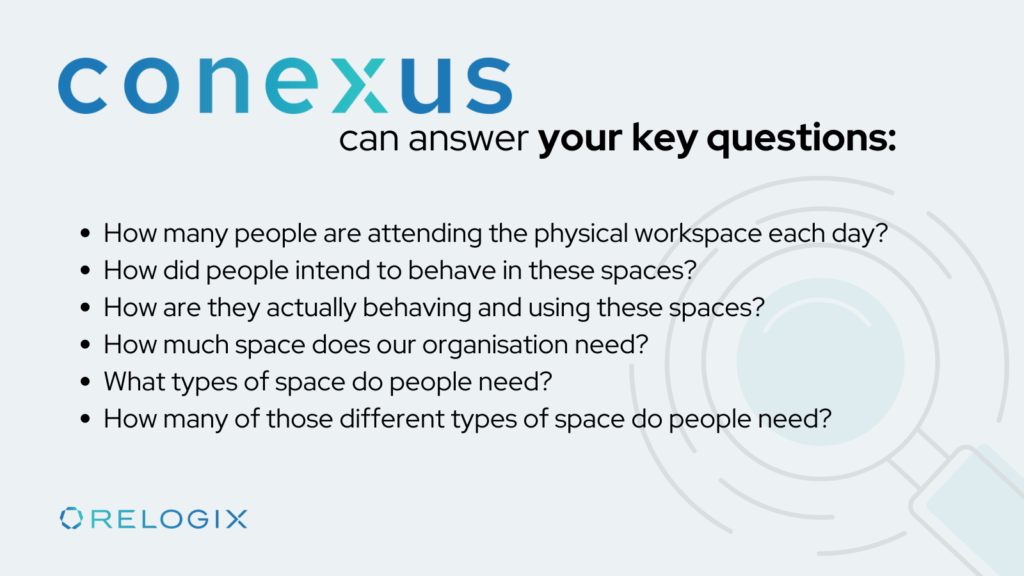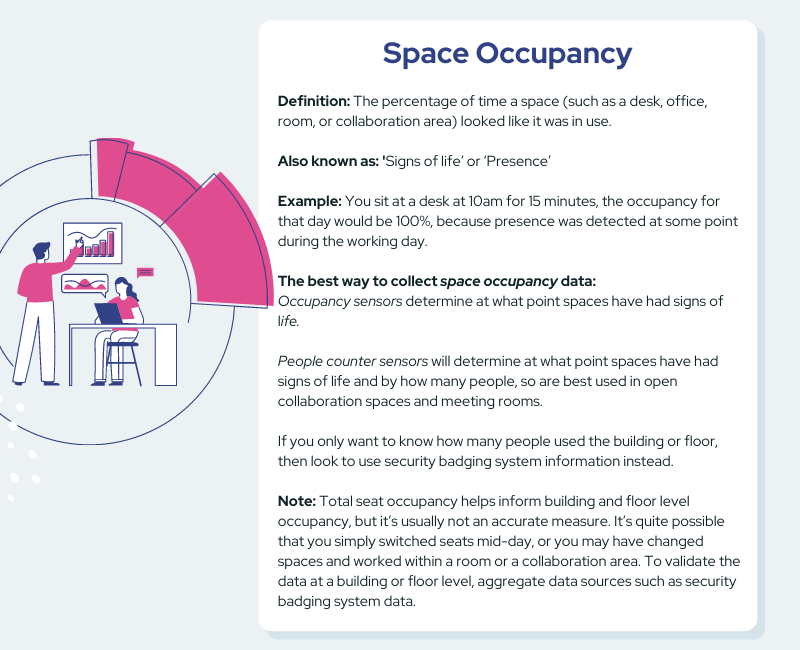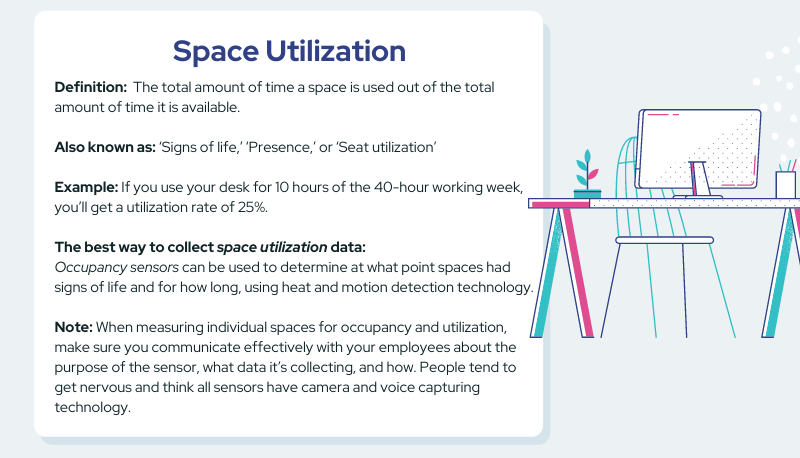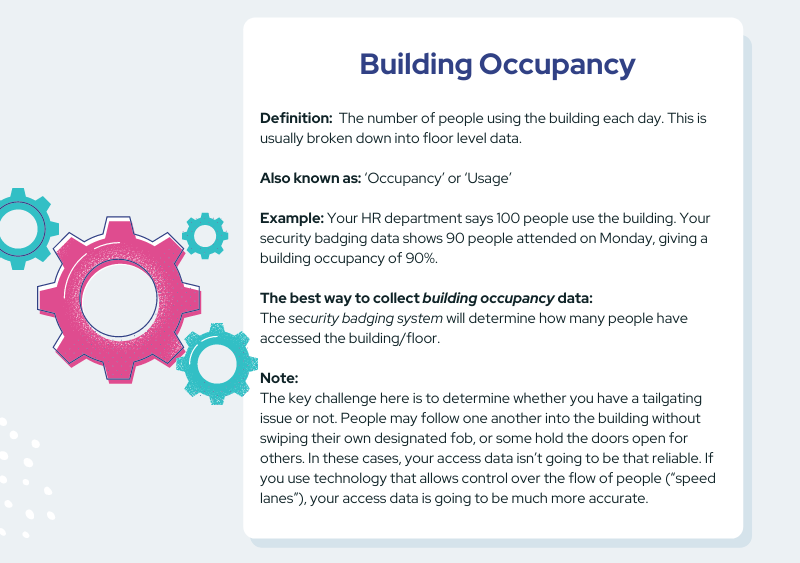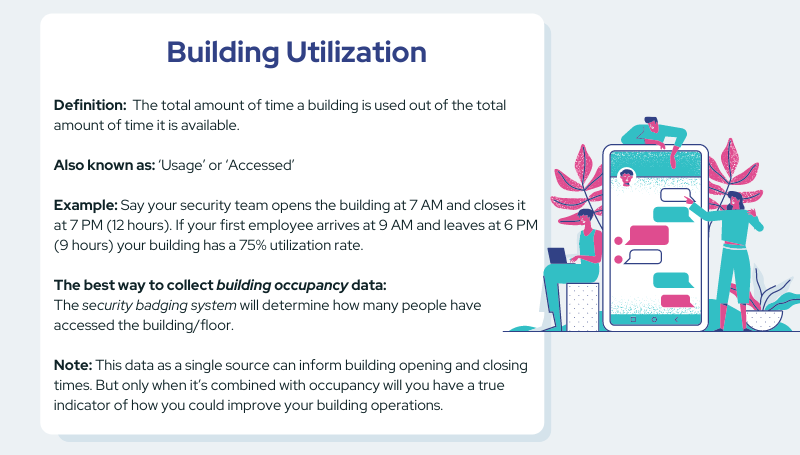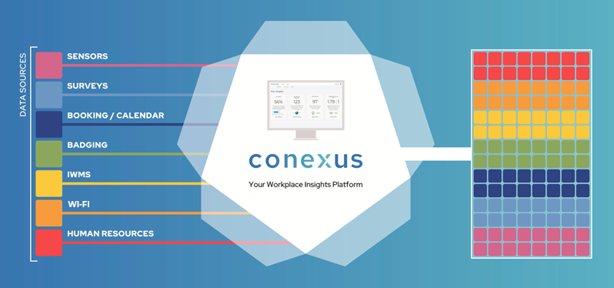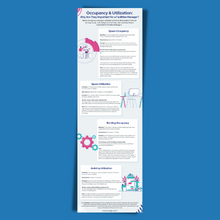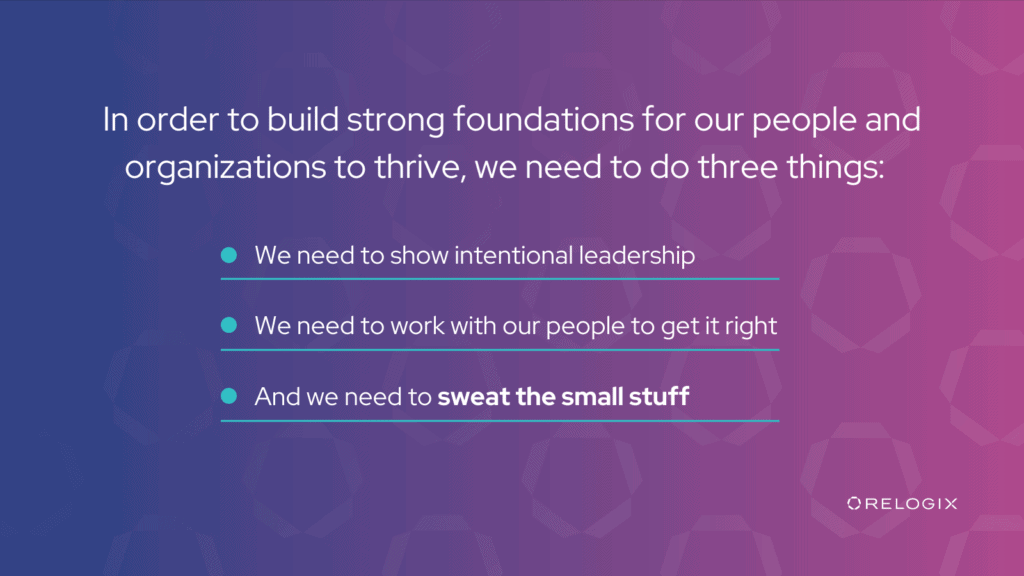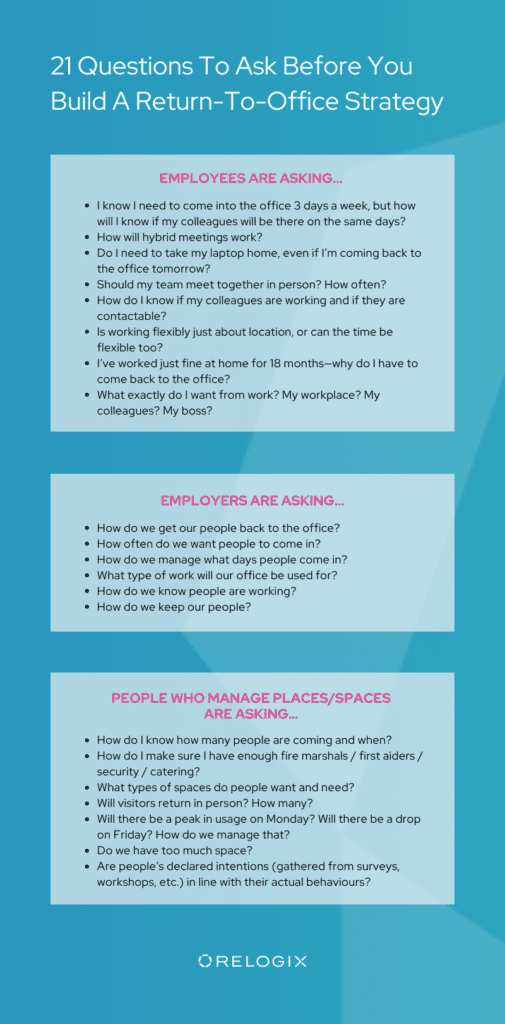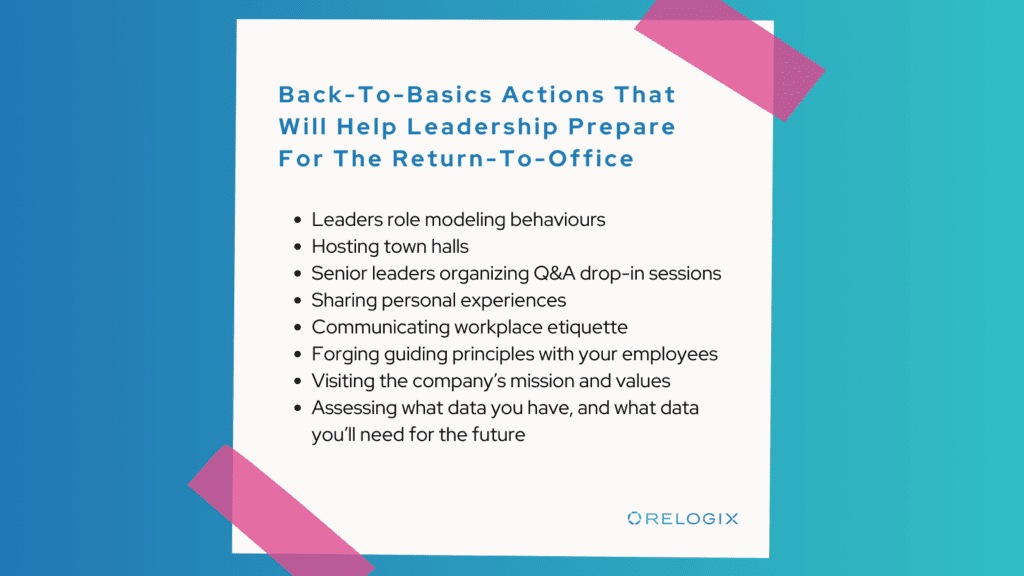Transcript:
Sandra
Hey everyone, welcome to Let’s Get Real with Sandra and Friends, a workplace consortium podcast brought to you by Relogix. I’m excited to be sharing conversational musings about current events and how we envision the ever-changing world of work. I’m Sandra Panara, Director of Workplace Insights at Relogix. With 25 years of hands-on experience, I help value engineer global workplace portfolios and employee experiences by aligning workplace analytics with corporate real estate needs.
Have any questions, comments, or suggestions for future podcasts? Please drop me a line at [email protected].
Today I’m co-hosting with my special guest, Simon Davis, the Senior Vice President of Workplace Technology at Impec Group. Simon leads Impec’s workplace technology practice. As a recognized thought leader in real estate technology, Simon has nearly 20 years of related experience. He is the lead faculty on CoreNet Global’s Masters of Corporate Real Estate professional designation program, and assists CoreNet global chapters across the Americas with developing technology symposiums. He also serves as event chair and strategic advisor to the International Facilities Management Association IT community, and is part of the workplace Evolutionaries Phoenix hub. Before Impec Group, Simon worked for leading technology solutions including experts in machine learning, virtual reality driven design, workplace and space optimization, and integrated workplace management system consulting and software.
So welcome, Simon! I’m really happy to have you on as my guest today. Why don’t you tell us a little bit about yourself?
Simon
Thank you, I appreciate the time. My name is Simon Davis, I’ve spent about 20 years now working in real estate technology, focused on the corporate side of the house. Maybe not what I wanted to be when I was growing up, but it’s certainly become a real passion and drive in my life. I’ve formulated many friendships out of all of my work and activities. I’ve really done most of the different avenues around real estate technology from working on the vendor side, developing and selling products, and working on the consulting side for companies large and small, helping to advise clients on the type of technologies they need. I’ve also spent several very entertaining years with a series of start-ups, helping to develop products and also trying to meet needs in the market that I felt were unfulfilled.
Recently, about 9 months ago, I joined a company called Impec Group. Impec has been eye-opening for me because they gave me a mandate to come in and do what I felt was necessary in the market. And with all my years of experience on the various sides, I felt the one area that was truly lacking was companies that were agnostically advising clients on the right technology. It seemed that companies either favored particularly technologies because their teams were trained in it, or companies were even getting referral fees for recommending specific technologies. I felt that the end user, the corporates, weren’t always getting the right advice coming from the right position. I wanted to establish a consulting practice that could come in and quickly help clients get to the crux of their pain points and provide them with the right technologies and the right options in order to solve those pain points.
Coupled with that, one of my big passions was trying to identify new technologies that people weren’t aware of that really mattered. One of the big concerns I see these days, if you look at organizations like MIT and Unissu that track these things, you’re looking at somewhere between 10 and 12,000 players in the prop tech market, which is a very nebulous thing in itself. I find there’s a lot of technology out there that was built for the sake of it, solving a problem that might not exist. It might be cool and sexy and fun, but it’s not necessarily getting to the underlying issues clients are facing. So, on that side of the house, I’m identifying companies that are in that very early start-up mode that don’t necessarily need my help from a financial perspective, but more from a positioning perspective and introducing them to clients and prospects that have the problems they’re actually solving.
So that’s my journey and how it’s crafted what we’re doing now at Impec Group.
Sandra
That’s fascinating. We seem to have a little bit of a similar background, because I also started my career in the IT and technology space, way back in 1988. I fell into corporate real estate by accident—I just applied for a job that at the time was office admin/office services, and that role expanded over time. Back then my thing was learning about how to use technology to help you in your day-to-day, at a time when you didn’t really have prop tech readily available. There probably was some stuff back then to manage leases and things like that, but that would have been pretty basic things. When you look back on 15, 20, 25 years ago, and how much prop tech is out there today, there’s a huge mountain of tools out there now. Thinking back, if I was in that role today, where do I even start? How do you figure out what tools are out there and what tools you need? This is very timely because obviously workplace technology is on the rise, lots of start-ups in that space are building new technologies to help organizations manage the workplace. I’m curious, based on what you’re seeing and experiencing, what are companies wanting to measure with these technologies?
Simon
It’s a great starting point – intriguingly I would say that a lot of companies don’t know what they want to measure, or what they really need to measure. And I find it really intriguing. There certainly is proliferation of tech in the market, so there’s a lot of marketing dollars and a lot of investment going to these companies that are certainly striving to be successful, and I’m seeing end users get sucked up in the flow of marketing and events and feeling like they have to buy this tech. But when I sit down and talk to them about what they’re trying to achieve, they don’t necessarily know what that is.
I have one very specific example where a friend of mine said, we need to get a sensor solution by January. I mentioned that I felt that some of the solutions they were looking at weren’t necessarily the right ones, that even by January they might be a little bit redundant, and she said to me, Simon, the CEO wants technology in to measure how many people are coming into the office.
I think you’ve still got a lot of knee-jerk reactions to the pandemic, when it comes to looking at technology around utilization from that perspective. The reality of it is that if you’re just really looking for something to help you determine the flow of people coming back, you can get enough level of detail using a badge card reader. You don’t have to invest in costly infrastructure to do that, or you can look at some more throwaway technologies that can do a great job, but aren’t necessarily a massive capital investment.
That’s the biggest issue right now. People don’t necessarily know what they want to measure, but short term, they seem to want to prove that people are coming back in. I think the smart money and smart players in the field are looking more at the long term. They know that sensors do have the ability to show you that data but more importantly, they can do a lot more. I’m actually hosting a webinar in a few weeks with speakers from Uber, Microsoft and Oracle, around the question, how do we use tech in order to make better space? As we come back into what is likely be a more collaborative area, what spaces are particularly good or bad, by clients, based on utilisation?
The other big piece is going to be looking at the question, how do we make real estate more purposeful? For example, using sensor technologies to identify things like, if our standards say we should have a 6-person meeting room, how often are there more than 3 people in that room, or should we really be building 4-person rooms? And if we have built space for drop-ins and we find that people are dwelling in that space for 8 hours a day, we should re-evaluate what we’re building and how we’re building.
I firmly believe that the pandemic is going to make people more hesitant to go into the office, not from a health perspective, but just from a quality-of-life perspective. I do feel that companies are going to really need to focus on creating a valuable, meaningful workplace in order to get those people back in to the office at the right times. I certainly see that the right types of sensor solutions and data can help do that.
But I think there’s a bit too much short-term motion with the use case. I think people need to focus on, what is the long-term benefit of doing this? Should we be doing this? Can we make do just with badge tape? Because maybe they can! And if not and you’re looking at a longer-term solution, it probably needs to do more than just track utilization. It probably needs to be able to help you understand things like indoor air quality and temperature, and other key aspects of the space as well, because I think those elements, and being able to share that data with your employees, is also going to help encourage people to come back into the office.
Sandra
You’ve touched on quite a few points—the first one I wanted to make was about the pandemic specifically and how that’s really pushed the need for tech in the workplace to the forefront, just because people are trying to manage the safe return to office or just making sure there’s some sort of control in terms of not having the densities that you had before. But you made the point that there are existing data sets within an organization that you can actually use where you don’t necessarily need new technology to do, which lends itself to the whole idea that generally you need to crawl before you can walk, and walk before you run. Are you seeing that companies want the hardcore technology just for the sake of having the technology because it’s available and therefore sort of discounting the existing data sets that are within their organization? Or is it just purely because they don’t really know what the capabilities are with respect to the data sets they do have within their company?
Simon
I think there are certainly instances where you might have a CEO or a head of real estate going to a really cool webinar about a sensor technology, they really like the sales pitch, they really like the visuals, and they say, we’ve got to get this, without really thinking about the purpose of what they’re trying to do. And I think absolutely, they do this without realizing the level of data and information that you can get to without having to make that investment.
For me, the biggest piece is trying to make people think, why are you spending this money? Because if you’re buying sensors that really just track entry and egress and spending millions of dollars, in my mind, that’s money ill-spent. Yes, it’s going to tell you that information, but I think most people would probably opine that in the next 6 months to 12 months, all our data is going to tell you is that we have less people in our office than we expected. So we might get a better level of accuracy—we might say there’s 48% of people coming in whereas your badge readers might not pick up that level, and it might be able to tell you what days are peak and what aren’t, but I don’t feel that investment for that specific use case is worth it, given you can use other data sets.
I see a lot more outside influence in real estate than you ever had before. It’s ironic, because I think real estate leaders for years were asking for a seat at the table, and now the pandemic is giving the whole C-suite visibility because of the need to attract and retain talent.
That was certainly a theme prior to the pandemic, and I think the forward-looking countries and companies were doing that. This is not new. I worked for an Australian company for several years, and 8, 9, 10 years ago the Australian market was going to more of an activity-based model where you weren’t expected to be in the office, it wasn’t 1-to-1 people to seats. So there has certainly been a more holistic view of this.
A friend of mine runs a company that never would have gone to a hybrid model without the pandemic happening. It just wasn’t in the nature of the company, and I think the executives use the stories to the employees that working from home doesn’t work. But now you have an entire globe that can tell you it does. There might be some issues with it, but it does. And the big twist was seeing now the employees have some of that power and that say more than they ever have before.
We’re also seeing the Great Resignation. Our friend Stan Gibson posted the other day about 14 million people having resigned since April from their positions. And I think that’s the fear factor, that you’re going to start losing valuable members of staff, and some companies have. So I think we might have to start looking at some different equations around real estate for how you determine what you should measure by. Because if you look at just pure attrition cost, in a market like I am in Phoenix, losing several high-level employees, executives, etc., may well be more than the actual cost of retaining space that’s not being used. If you’re paying $6000/sqf in Arizona and the average replacement cost is 2x salary, there’s not that many people you’d have to lose to write off the cost differential. And I think people might look at those models slightly differently, which again, would tell me you don’t need to necessarily make a drastic decision about your real estate now because your focus should be on keeping your employees and keeping them happy.
Sandra
I think that’s a valid point, because I think a lot of companies are talking about making decisions about the future of real estate, with the pandemic kind of still hovering over all of us. It feels like it’s still too early. You get some of the insights that people are not returning anywhere near the volumes of what we had before. There’s some consistency that we’re seeing in terms of 20, 30, very rarely 40, 50% back in the office. I think it requires more time to trend and see, is that number going to continue to climb, or is it going to stay at that 30 to 40% mark?
Which, interestingly enough, if you think about how organizations were using space before, that even though working from home or just working out of the office wasn’t necessarily a program that was formalized by many companies, it didn’t mean that it didn’t happen. Like you said, if people weren’t looking at the data before, it seemed like it’s a huge swing from them thinking that they were 100% in the office when maybe they were only at 55, 70% on a good day, and that’s being really generous, and now seeing maybe 40, 50% again on a good day—it seems like a drastic reduction. There’s a lot of eyes now looking at corporate real estate, and the cost savings seems to still be up there, because there’s a tremendous opportunity to say, well, if we don’t need that much space then we can reduce the amount of space, still keep potentially some vanity space or look to alternative spacing to support our workforce based on whatever the requirements are, or that we deem are necessary for our company, and then call it a day.
Simon
I couldn’t agree with you more. It was crazy to me—many years pre-pandemic you would go to a cubicle farm or an office or a large corporation, you’d walk around and you’d see a few heads, and the comment would always be, oh you know it’s normally busier than this. But if you actually look to the empirical data, as you pointed out, 40 to 60 to 70% was good pre-pandemic. If you weren’t a butts-in-seats kind of company where the expectation was everybody was in, any of those Silicon Valley companies having that number of people actually in the office was good. So I fully agree, if anybody’s expecting 80, 90, 100%, they’re going to be sorely mistaken.
Again, the data was there previously, but people either just weren’t looking at it or they wrote it off as an anomaly. That is absolutely going to change. I think regarding the information at the forefront of this data, the importance of it is right there. And it is going to be scrutinized and it’s going to take a while for everything to play out, and for individuals to work out where when and how do they work best.
I’m in a city in a state that frankly, was probably less oppressive during the pandemic than many other places. I think for people that have been in true lockdowns, I’m thinking of friends in Europe and Australia, they may all say, we want to get back to the office, and they may well go straight back when things open because they’ve been working for home during a pandemic where they can’t go out and do anything. But when you can actually leverage your time, and spend more time with your family or on your golf game or whatever your hobbies are, because you don’t have to travel 2 hours a day, I think that could change. So I think in some of those regions, you might see a big bounce back and get up to maybe even pre-pandemic levels of occupancy, until people sit back and realize, wait a minute, I don’t necessarily have to do this commute every day. And I can do things and work in a different manner. It’s definitely going to take some time to play out.
Sandra
Another question I had was with respect to thinking about corporate real estate analytics in general. We’re talking about occupancy planning, trying to understand and quantify the opportunity for reduction, redeployment, cost-avoidance, all that fun stuff, and I’m thinking about how it was done in the past. I’ve been doing workplace strategy since 2007. Most of the companies I worked with in the past on the consulting side typically hired consultants to do that. So whether you were part of a large consulting firm, a design firm, furniture suppliers, these were the companies that were coming in and doing an assessment of your space, taking whatever data they could through surveys, looking at badge data or whatever else, going away to work their magic in Excel, and then coming back to the organization with some recommendations, and then obviously with goods and services to follow. With the advancement of workplace technology, are you seeing that there’s more of an appetite from organizations to do it themselves? Or are you seeing that it’s still pretty much dependent on these larger organizations to do that on their behalf?
Simon
I think the appetite is increasing for companies to manage a lot of that information themselves, and I think part of it is driven by cost. I think in the past, these were treated like a one off—they say, we’re going to spend $100,000 and someone will come in and tell us what our portfolios should look like for the next 3 years. But my view, along with seeing recent hires of friends of mine into big roles that are more workplace strategy focused internally, is that’s going to become a table stakes position. Somebody that can actually look across the board and say, where should we be growing, where should we be shrinking, where do we have need for specific types of space, taking into consideration things like cultural aspects, geographic aspects, even just age of the employees and what they might want.
Pre-pandemic, there was a gentleman I met from Cisco who said, your building is the body language of your company. And I think that’s still going to be true to an extent, but now you’re going to also have the workplace experience, whether that be a physical, in-office, or that be the ability to work in a hybrid manner, be big, big aspects of attraction and retention of talent. We’re seeing that already. We’re seeing people leaving positions because they don’t have flexibility. We’re seeing companies like Twitter very, very openly coming out and saying hey, if your company isn’t remote first, or remote favored, then come and join us.
I think having that internal resource is going to be necessary in order to make the right decision for the company, and to understand those cultural aspects of the organization so it’s not cookie cutter, it’s not one size fits all. It’s very much looking holistically. As I say to people, what are we trying to be where we grow up? Where is our company going, where are we focused? And I think it’s going to be a challenge for a lot of people because it’s something they haven’t necessarily done in the past. They probably have a large investment financially in real estate. And there’s certainly also an emotional attachment—if you’ve been with a company for even 5 years and going to the same desk every day for 5 years and now all of a sudden, is it there, is that office even there—it’s going to have an impact.
I believe those internal-focused roles are things that need to be looked at in a similar vein. Today so few companies actually have a real estate technology leader within their organization. I can look at companies like Salesforce who have for many years had them, but a lot of companies don’t have that kind of a role. So they don’t have somebody holistically looking at technology, or the workplace, and I think those are two things needed in order to ensure that the overall strategy of retention of those valuable employees is at the forefront.
Sandra
That’s what we’re seeing as well, that the role of corporate real estate analyst is a relatively new role in organizations. I think that’s probably the reason why a lot of organizations are struggling with trying to voice what they’re looking for, what they want to achieve, what their objectives are. They don’t really quite understand it, and so they look at the shiny object over here—hey, there’s some cool technology, and that’s what we need—and then they bring that technology into the workplace, and are disappointed because it doesn’t deliver what they expected, and they didn’t really have an idea of what it was supposed to deliver in the first place.
The other thing that we find that’s really interesting is the role of IT and HR. Prior to Relogix, I worked in an organization doing workplace strategy enablement, working with HR and IT doing a kind of blend of the corporate real estate analytics with people analytics. It’s not just about occupancy planning per se in terms of how many people can you fit into a building, but also around growth strategy, location strategy, hiring strategy—when you bring this data together and you start to understand the demographics and the makeup of your organization, and what the trending patterns are for certain age groups or tenured groups, or the combination thereof, you can look at that and say, okay, if this is what we look like today, what’s our organization going to look like 5, 10 years from now in terms of the makeup of the organization. You can start to use some of that data that you’re observing and saying okay, this is how this particular group of individuals use space, then you could use that to help shape what the potential future of the office might look like.
So it’s really fascinating, but one of the things that I’ve always been a little bit dumbfounded by is the number of organizations that will do analytics, and turn to their BI team and say, see what you can do with it. But that’s very hard to do if you can’t actually talk that person through what it is that you want. What are the types of questions that you want to ask your data to be able to draw out the insights that you’re looking for? Technology doesn’t do that for you, that’s the business subject matter expert that has to be able to lead that.
Simon
It’s an interesting view—I was going to make the point that now, as opposed to 3 or 5 years ago, there are technologies out there that can help companies get a long way along that journey. I look at an organization like BeyondHQ and Continuum that are commercially available, shrink-wrapped product that help you make some of those determinations. Then I look at other companies like NavigatorCRE who’ve really burst into the scene with BI and data visuals that frankly, blow away companies, some of the bigger service providers that have spent millions of dollars trying to build these solutions, and they put the power of the data in the hands of the user.
Now, to your point, you have to be an astute user to understand exactly what’s coming to you, but technologies can help you with different ways of strategically planning out space, with volumes and volumes of data that you might not traditionally get access to because you’re getting them through your service provider. This is going to put the occupant in the driving seat more and more.
We’ve long had this conversation with friends in the industry about why there isn’t a Zillow for commercial real estate. Why isn’t there a way to connect that data? At the end of the day, it is data. It’s getting the right level of information, and it’s another area—a bit off topic, but—I think could change coming out of the pandemic. Because I think people are going to look at these things with a lot finer view, to say, really, why aren’t we doing this in a more automated, more consistent fashion? In my very simplistic view, if you have a landlord that says, I’m willing to rent this space for $65/sqf, and a tenant who’s willing to pay that, why can’t you connect the two? Right now, the power is probably not in the hands of those two entities as much as it will be going forward. Again, it’s all driven on data and driven on the fact that you can now access commercially available tools to do these things that in the past were done in smoky rooms in the back of an office with a lot of proprietary information.
Sandra
So from a user perspective, considering your feeling that more and more the data and the power is going to be in the hands of the user or the tenant, who do you think would be the ideal consumer of this data within an organization?
Simon
I think, from a consumer perspective, in terms of using data around utilization and workplace etc., there has to be dedicated resources in those kinds of roles. As to your point, they understand what they’re looking at and the value of it, and I think in some areas that just doesn’t happen. I think in some areas, data is getting produced, it’s getting thrown into a PowerPoint or other application, and no one’s getting the value because they’re not actually leveraging that information.
I firmly believe, with a few different data points, you can make a lot of good decisions. If I’m the head of real estate, and I can go to a system and say, show me what leases I have expiring in the next 18 months where utilization is less than 30%, and we have a deferred maintenance cost of X, then that should point me to space we should look at getting out of. And that was even pre-pandemic thinking. So it’s really about taking that data, understanding it, and understanding the value.
One of the greatest analogies I’ve heard was somebody talking about space and saying, they don’t build the parking lot at Nordstrom’s for Christmas Eve. You don’t build space for the possible peak of what it’s going to be. You have to look at the value of it on an ongoing basis. I think that’s going to be one of the biggest challenges for companies. I see, certainly in the US, that traditional companies are saying, we’re going to go hybrid, which can mean a lot of different things but to most, it means you work from home 2 days a week, which to employees means I don’t have to come in on Monday and Friday.
Well, if you can’t do anything to divest of the real estate, then in a year or two years’ time, the CFO will come and say, we tried this hybrid thing, it didn’t really work, we didn’t save any money. You may have way happier employees because of it, but unless you’re able to shed some dollars off the bottom line, then the natural assumption is going to be to push back. That’s where the value of the data and understanding that information really comes to play. I think also, taking that information, you can use it help people determine where their schedules should be in terms of when, where, and how they work. If I was told tomorrow that 3 of my team members are going to be in the office, then maybe I’ll think about going into the office. So I think the data again will drive those behaviours and understandings, but it needs to be appropriately managed, visible, and it needs to tie into other key data sets.
Sandra
You briefly touched upon predictive analytics, we could talk a little bit about that and AI—what are your thoughts on the role and value on artificial intelligence and predictive analytics, specifically in planning for corporate real estate in the future?
Simon
AI is a bit of an overblown term and is tied to a lot of things that aren’t necessarily truly AI-based, but where I think the value comes is in predictive analytics, the predictive capability to understand how much space a company needs and how it’s being used. But then at the micro-level, also, to understand how we should encourage teams to use this to work the best way they can. Not to force them back into the office, but to understand, for example, if this team works this way, then this is the right combination of collaborative vs heads down, and this is how they can work.
I think that also can bring in, from a cost perspective, a third-place component, which is saying, ok, maybe today I don’t want to drive all the way to San Francisco, but I want to be around people. I don’t want to work out of my office because somebody’s knocking down a wall, so I want to go to a WeWork or a Convene or one of those third-party places. And I think from the analytics perspective, it’s coming up with a mechanism to understand all of that.
But my biggest caveat is, without it being onerous on the employee. I was talking to a friend the other day, and they rolled out a workplace experience technology at one of their facilities that was opening up in Australia, and within a week they were asked to remove it because it was too convoluted. You look at a lot of these technologies, and standalone they look great. They do really well. But how well are they playing to the infrastructure of a large corporation? How many apps do people really want to open to get to where they need to get to? And I think that’s where the complexity causes some issues, because you’re going to need the intuition of the technology to help leverage the predictive analytics to be of value. Because if you have a great predictive engine, but I’m never logging in to be told when I should go into the office or what spaces I should use, then it’s pointless.
That’s where a lot of companies are missing the mark. In the sensor world, we just did a report that we made available, where we looked at 20 sensor vendors and I think of the 20, there was only 1, Relogix, which was actually building a platform with the view of absorbing data from other sources. They’re all hardware plays, and they’re not really looking at being able to ingest other data. And to me, that blew my mind, because I’m thinking—longer term, surely the play is the analytics. We don’t really care who the sensor vendor is or what type of sensor this one is, we care about what information we’re getting out of it.
I’m seeing a few different approaches there—one large entity I’ve spoken to is saying, their sensor vendors have to adhere by specific standards, and another large company I work with have said, we’re sole sourcing one product. Which is dangerous. Does that product do what you need it to do? And I do think there’s that gap in the market for an analytics platform that can ingest all of this data around every aspect of how space is being used, regardless of whether it be badge reader or Bluetooth or WIFI or radar or passive infrared, whatever it may be, but to bring that all in—because the other point about infrastructure and why smart lighting sensors never really worked, because if you have to retrofit every single one of your buildings for a specific brand of light, you’re not going to do it.
There needs to be some more thought about that and some more commonality, and an approach to looking at it. The data is the key, the winners are going to be the ones that come up with the best platforms to ingest this data no matter where it comes from. And that’s why when I look at companies like NavigatorCRE, that’s their bread and butter. They pull in information from any source. It might not even be traditional real estate, to give you additional value, and to making those real estate decisions.
Sandra
I know personally I have a gazillion apps on my phone when I was doing consulting. Depending on who I was working with I had to use this app, that app—okay, which app am I supposed to turn on? That gets annoying very, very quickly.
Also, we’ve often thought about, from a purely other-data-source perspective, can you extract that kind of insight from other data sources that will essentially help you understand how people are working together? So, rather than using the active data that might come from an app, can you pull that in from looking at information from calendar data? Or from collaboration that’s taking place? Who’s talking to whom? Not necessarily the subject matter, to some extent, because there’s value in that, as you start to see the networking that’s happening within the organization.
And what’s interesting about that is, as we hear more and more these days about enticing people to come back to the office and all this talk about creating great amenity spaces or this hospitality environment, that’s all great and it may have a wow factor that first day or two, but that wears off really quickly. But when I think about what drives me to want to go and work in this space it’s really, who’s there? Is it someone that’s going to allow me to grow in my career? Is it somebody I want to learn from, that inspires me? That kind of stuff or, just colleagues and coworkers working on a project together, saying let’s all get together today because we’re all going to be in the office, and we need to hammer out a couple of things and it’s better to do it in person. So being able to observe the patterns of that kind of interaction that are taking place, and marrying that to occupancy data and dwell times and all of these things where again, it just becomes another dimension or lens of how you look at your occupancy data, I think will help drive the predictability element. To say, these are the patterns of how people work, this is who they’re working with, why they’re coming into the office and how long they’re staying—looking at that data will help predict potentially what’s going to happen in the future.
Having said that, I was having a conversation this morning about the unpredictability of occupancy and utilization. I’m sure you’ve experienced, surveys go out all the time asking people how many days a week do you want to come into the office, and people will respond a certain way, but then reality is very, very different. So, how do you guess which days Jane Smith is going to be in the office, or the hundred Jane Smiths that are going to be in the office to know that, today we have a demand for X number of seats and tomorrow, a demand of Y. There are ebbs and flows that happen over the course of the day, the week, the month, so on and so forth.
This leads me to the next question which is about what you said earlier about how much of the analysis that was done before was based on moments-in-time data, so just kind of looking at a study, a snapshot, and using that data to form the design and then 3 years later we’re doing it again because things have changed, vs. more of this in-demand real-time data that not only serves to inform occupancy but also can help with other things, to kind of help companies better manage their space. What are your thoughts on that, where it’s more of that always-in, always-on type of situation?
Simon
My boldest prediction coming out of the pandemic is I think you’re going to see the behemoth technology companies, the Microsofts, Googles, Salesforce, come out with products that will help with this. Because I think they’re now realizing the value of the technologies like Slack and Teams etc., coupled with being able to understand and interrogate the interaction of calendars and correspondence. And I think a reason that those companies have never really gotten involved in real estate or workplace in the past was because they didn’t see a big enough dollar value associated to it. And I think that’s changing.
I think if you look at Salesforce, who’s very much going digital HQ, and that’s their sort of mantra, they’ve got to see that the products they produce, slacks, CRM tools etc., can actually really help enable a more fluid hybrid workforce. Microsoft and Google even more so, if I can see, for example, how often is Simon meeting with his team, where is it, how often is it remote, how often is it in person—then I can couple that with sensor data to understand what spaces are best to be used. And then I can look at other interactions through access to those unique data sets. Then all of a sudden, I do get that real-time view of where people are best working, which I think should be the question. I think it’s asinine to ask somebody how many days a week do you want to be in the office because it’s going to depend on the week. There might be a week where you want to be in every day because you want to be heads down, you don’t want distractions at home, and there might be other times that you’re not in the office for a few weeks because you’re doing things of a different nature.
To me, that collision of these bigger companies with a product to sell that is enabling hybrid work, I think will really change our industry drastically. I think, if I was out buying software right now, even looking at booking software of that nature and it didn’t integrate with a Slack or a Teams or a GSuite, I wouldn’t even look at it. Because I think that’s the level that you’re going to get to. I think those players will come in at some point with commercial products that can do a lot of these things, because they’re the ones with all the magic—they have all of the data around connections, correspondence, and if you layer in that sensor and utilization information as well, then that is the secret sauce that people are looking for.
Sandra
I agree. I think from a booking software/calendar, that’s more the intentional side to understanding what the planned demand is for space. It’s similar to asking on a survey, how many days are you planning to come in—I mean, Calendar’s probably really accurate in terms of what’s happening in the course of your day, who are you interacting with, but it doesn’t tell you if it’s a virtual or in-person interaction, so that kind of gives you a little bit of uncertainty around where is that actual interaction happening.
I was just on a call with one of our partners about IWMS and how similarly, IWMS also can illustrate what the intent was for design. So, if you think about going in and doing all the research, whatever the outcome is of that study that ultimately leads to a design, which gets fed into your IWMS from a program perspective to say, ok, we have X number of employees, we provision X number of desks and meeting spaces and so on and so forth—and so even as a starting point, if you just extract the IWMS data and you look at that, you can say, okay, how did we plan our space 10 years ago? What were the assumptions? And now look at it from a standpoint of what’s actually happening today. How are people actually using the space? There’s always misalignment. And that’s where that opportunity is. How do you bring those much more in alignment with each other?
To your point about the variances you see from day to day, week to week, at least in my experience working with gazillions of data lines over the years, is that over time, peoples’ behaviours generally normalize. You’re going to get the randomness of one week they’re in 1 or 2 days and then the next week they’re in 5 days a week. But when you’re looking at it over 6, 12, 18 months or so, quarter over quarter, year over year over year, you generally see plus or minus 5% per user. You generally see consistent behaviour. I think what’s going to be interesting is how the pandemic is going to impact that. We didn’t have that flexibility before, and now we do, and some people have a preference for the office or for not working in the office—is that going to normalize as well, or is that going to be something that’s always fluctuating, depending on what’s happening? Because you have the ability and flexibility to use the space like a tool that you didn’t before.
Simon
That’s the key aspect, that space is just another means to work. That’s what its purpose is, it’s enabling you to work more effectively. Right now, the one business I would not like to be in right now is selling CAFM ). I think traditional space software could, in the short term, die as a result of what could happen out of the pandemic. Companies are going to be way less concerned about things like chargebacks, way less concerned about physical allocation of seats, actual booking into space. I can definitely envisage, if you’re a company that says you know what, we’re going to go hybrid, we’ll allocate 5 to 10% of our seats fixed for people that need them, everything else is drop-in, and all you’re actually doing is requesting access to the building so you understand the supply and demand—why do I need a CAFM solution if that’s the case? I probably don’t.
And I think some of those things could dramatically change. For example, if I don’t have people allocated to space I’m not going to need a Mac capability, because we’re not going to be doing those changes because we’re just going to have space for people to drop in, use, and drop out. And I think some of those things intrigue me, looking at vendor consolidation of companies that have got now several CAFM solutions under their wing—that’s not a bet I would have laid. I could be entirely wrong, but I think the trend is going to be away from that. I don’t see anybody coming post-pandemic and saying you know what, I really need to understand down to the inch my space, so now I’m going to invest in a CAFM solution to give me BOMA measurement standards. That whole thing is going to go away. People aren’t going to care about those comparatives.
Today I was speaking to a friend of mine about a well-known company who’s decided to let all of their leases lapse, take the savings from those leases, and portion on a monthly basis for employees to use so they can either invest in home space or they can use it to go to a WeWork or the like. That company is not going to need those types of solutions anymore. The landlords and the WeWorks might, but I do see there being some real sea-changes coming out of this.
I think, frankly, a lot of companies may be talking to peers, but they’re not necessarily overtly coming out and saying what they’re going to do. When the chips start to fall, I think people are going to be shocked by how big a reduction a lot of companies are going to make in their physical footprint. There’ll be some, Microsoft and Facebook, probably the most active, and Google with their new HQ building in New York, that are looking at more space because they want more collaborative spaces, but you know, they’re also making a lot of money. I think they’ll be in the minority, and I think the hybrid model will veer more towards remote and third-place work, and therefore the impact and need for some of the traditional technologies may go away entirely.
Sandra
I totally agree, I think the flip side of that is that if systems or tools like IWMS are no longer going to be required, and co-working does take off, like many are predicting—I too have actually talked to a customer as well who shared a similar plan where they were just letting their leases lapse for now, and just waiting and seeing, tapping into the coworking spaces and allowing their employees to work wherever it is they felt comfortable. And when the dust settles, figure out what they’re going to do about their real estate strategy, to which I thought, that’s pretty brilliant that you’re able to do that.
But on the flip side, there’s going to be a need to figure out how to manage things like corporate travel, for example. When you used to do your own travel it was one thing, but then Expedia came to be and everyone could book their own travel, so they’re not going use the corporate travel contact, they’re going to go online and book their own tickets. So suddenly, the cost goes through the roof because the company has no visibility into what people are doing. Now, you can minimize that by giving people a fixed amount monthly for renting space or whatever it is, but if that’s not the case, where it’s just more of hey, companies set up a relationship with Regis or with WeWork or whoever, and you reserve a block of seats that are available for your staff, how can you know—are people actually using the space?
So they are pushing the problem to the outside world, and you have no visibility into how your employees are using those spaces, because they don’t have the ability to report back to those companies to say hey, you’ve got 50 seats but only 10% or 15% of those seats are being used. They probably wouldn’t even tell you that because they’re making money off of you regardless of whether you use the seats or not, right.
Simon
It’s an interesting point. I can see some of the smarter ones, and one I’ve spoken to a bit, and peers in the industry like RXR out of New York—they’re a landlord, but they’re really looking at how to do these things proactively. Because we know they’re coming. So, if you try to sit quiet and hope your tenants don’t realize nobody’s using the space and keep paying the rent, at some point they will probably not be very happy that you have been proactive. Some of those companies are looking at things like utilization and reporting it back to the tenants so the companies now have a space that’s being used. And I think that’s the right way to do it, because you need to have that visibility of data.
As well, unlike maybe coming into the office, I think the human nature is probably going to be, if my company is paying for this, then I do need to go in and use it. But again, the question seems to me to be more so, not how many days do I want to work at home vs third vs in the office, but what am I trying to achieve. What different work styles do I as an individual need to meet my job duties? And where can I deliver those best? That’s the question that just not enough people are asking. Because there’s a lot of vested interest in getting people back to the office—but that’s a different story we could probably spend another hour on. But it’s going to be interesting for sure, just to see how these things evolve.
Sandra
For sure. Well, thank you Simon, thanks for being a guest today, I really enjoyed hearing your insights and our conversation. Any final comments?
Simon
No, I just appreciate the time. I’d say certainly if you’re out there in the market and you’re looking at technology, be very careful about and very prescriptive about the use case you’re trying to meet. What are you actually trying to achieve? Because I think those sort of inadequately defined use cases and requirements for software are the reasons why people can end up with the wrong product. And there are many companies like mine and several others out there that are really geared around helping you ensure that you can make those decisions.
I’m always open, with our industry being as close as it is, to a 30-minute conversation with somebody just to help walk them through how they should start, and where they should look. That’s certainly something I’d be happy to offer to any of the listeners out there.
Sandra
That’s great. Thank you again!
Simon
Thanks, I really appreciate it. Take care!
